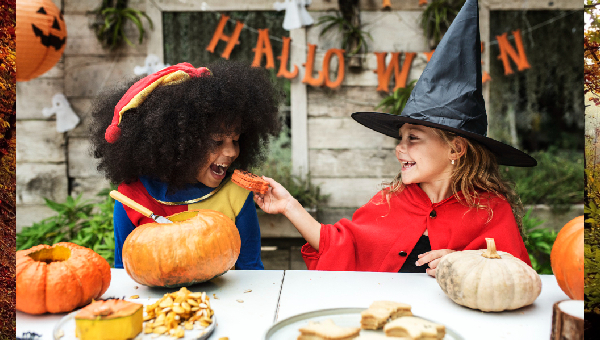The History Behind Your Favorite Halloween Traditions

People like Halloween very much. It is a time when the old and the young celebrate it without feeling the age difference. The ghostly decorations, party masquerades, and the freedom of the babies of the candy are the highlights of the night. Even though the customs and traditions we represent with Halloween today have their beginnings in ancient culture, they are now shared in many cultures and periods. Halloween celebration has gone from the old Irish festival of Samhain to a very different style of an American holiday. Halloween has changed over time and the range of customs has been diversified, ranging from the ancient Celtic festival of Samhain to the modern American celebration so that the festival has become a large collection of different rituals and practices. Now I want to show you interesting facts about some Halloween traditions you might have liked.
Halloween Origins and Beliefs: Samhain Vs. All Saints Day
The Celtic origin of Halloween is said to have its roots in the ancient Celtic festival known as Samhain, which garnered notoriety more than 2,000 years ago in what is now Ireland, the UK and northern France. October 31st, according to the Celts, was a crucial night when the deceased could walk amongst us as the dead and living worlds merged, beginning with summer and transitioning into the darkness of winter. They would light bonfires and wear costumes during Samhain to avoid being plagued by the vengeful spirits who might have returned to Earth.
The process took place in Europe, as the Catholic Church spread Christianity: Pagan holidays led to Christian ones. It was many centuries later that Pope Gregory III (in the 8th century) established November 1st as All Saints' Day, or All Hallows' Day, to honor saints and martyrs. The fusion of Samhain and All Saints' Day the pagan with the holy is what crafted our modern Halloween.
The Evolution of Costumes
On the eve of Samhain, costumes are an integral part of this Halloween celebration. Celts wore animal skins and heads just to disfigure their look before spirits that might harm them. They believed that by dressing this way, they would not be recognized by ghosts and spirits roaming around the earth. Such activity was referred to as "mumming" or "guiding," as participants would go around the houses, performing plays or reciting verses for food; a practice that, over time, turned into the wearing of the Halloween costumes that are spooky, amusing, or often pop culture-oriented in theme.
By the early years of the 20th century in America, costumes became very unrestrictive and playful. Nowhere was this truer than in that range of spirit fears no longer attached to particular costume creeds. Children and adults alike donned monster-witch garb as well as book, movie, and television heroes and heroines. Wearing Halloween clothes has now become a fun-related part of the holiday.
Origins of Trick-or-Treating
This tradition of trick-or-treating, whereby children, attired in their most elaborate costumes, solicit candy door-to-door, derives from a base deep within the history of several European customs. From among the most ancient precursors to the contemporary practice of trick-or-treating, one stands out: selling. On All Souls' Day, November 2nd, poor households were invited to the houses of the rich on condition that they offered prayers for the dead in exchange for food, usually a soul cake.
In Scotland and Ireland, the same children who would later turn up "guiding" in American folklore - the equivalent of that meaningless word disguise - donned costumes to beg for fruit, coins, or other street fare while reciting songs, poems, or jokes door to door. Coming up with creative tricks and dressing up for Halloween is a modern US Halloween tradition that only goes back to the 1920s and 1930s. But, with World War II, trick or treating had to come to an end, as there was a rationing of sugar. When the war finally ended, candy companies stepped into high gear, and trick-or-treating became a very commercialized activity centered on the obtaining of sweets.
Carving Jack-O’-Lanterns
The pumpkin lantern, simple, has lots of seeds and other things taken out. The pumpkin face is the most well-known thing about Halloween and it is the jack-o'-lantern. But this practice originally began with turnips being carved, not pumpkins. One widely-known story is that of Stingy Jack, an Irish folk tale from which the legend of the jack-o'-lantern originates. Legend has it that Jack played tricks on the Devil a few times and because of this, he was refused entry to either Heaven or Hell when he died. From this day on, Jack was known as 'Jack of the Lantern' or Jack o' Lantern for short and he was now doomed to wander Earth was antonym for a turnip until a piece of burning coal extracted from the stove was arranged in front of him so that it would light his way.
The Haunted House Tradition
A popular attraction at Halloween, many of the traditions for haunted houses come from ancient beliefs about spirits coming back to haunt those left behind in our world. Ghost stories as entertainment date back at least to the 19th century throughout the 19th century and especially around Halloween they loved ghosting tales. Sure, people told us stories of hauntings and ghosts and those stories usually took place in historical buildings. In the 20th century, clubs such as the Boy Scouts started setting up haunted houses to entertain and scare their communities in addition to private parties.
The attraction of haunted houses boomed in the 1960s & 1970s with all of the big elaborate Halloween decor and special effects being developed. Haunted house attractions today can be anything from a person in their home with some decorations to large professional operations run year-round with real actors and animatronics.
The Rise of Halloween Party
Whereas Halloween was originally known as a strictly child-oriented event and trick-or-treating, adults have now found cause to love the holiday and make it a big event for parties and get-togethers. The earliest aspect of the history of Halloween parties that can be traced back is harvest festivals and barn dances where communities gathered to celebrate the end of the agricultural season.
At the turn of the century, Halloween celebrations took over from pranks and property destruction, which was normal on Halloween evenings. Partygoers danced around and played games, like bobbing for apples and telling ghost stories. Halloween-themed foods - caramel apples and popcorn balls - completed the festive atmosphere.
Today, Halloween parties range from small family gatherings to great costume parties for adults, all with varied decorations, music, and food. It is no longer solely for ancient tradition but has become much more of a social gathering and entertainment.
Witches, Black Cats, and Superstitions
No Halloween could be complete with those images of witches and black cats. The association of witches with Halloween also has its roots in the medieval belief that they held two general meetings annually on April 30th and on Halloween night to meet the Devil.
During the witch trials of the 16th and 17th centuries, images belonging to these witches were connected with evil and fear because they were said to be magical. Over time, images of witches riding on a broom and wearing pointy hats became Halloween iconography.
More infamous is the black cat breed associated with witches in folklore which, if it crosses your path, is believed to bring bad luck. Nowadays, witches and black cats epitomize Halloween, but they're way less menacing and funnier than they depict them in their tradition.
Conclusion
Halloween customs have been part of a long time which have involved dressing up, making lanterns and celebrating the festival of Samhain in Ireland. Gradually, Halloween has been transformed from a Celtic Irish festival that was meant to pay homage to the dead to an internationally loved festival. Now, it has changed and become a festival to celebrate the creativity of both children and adults. Participating in this holiday by carving a pumpkin or dressing up to attend, you are drawing on some quite ancient traditions that have evolved to become the modern experiences we treasure today.
Do you like this article? Then you must read this: Pet-Friendly Halloween Costumes That Will Wow the Crowd








